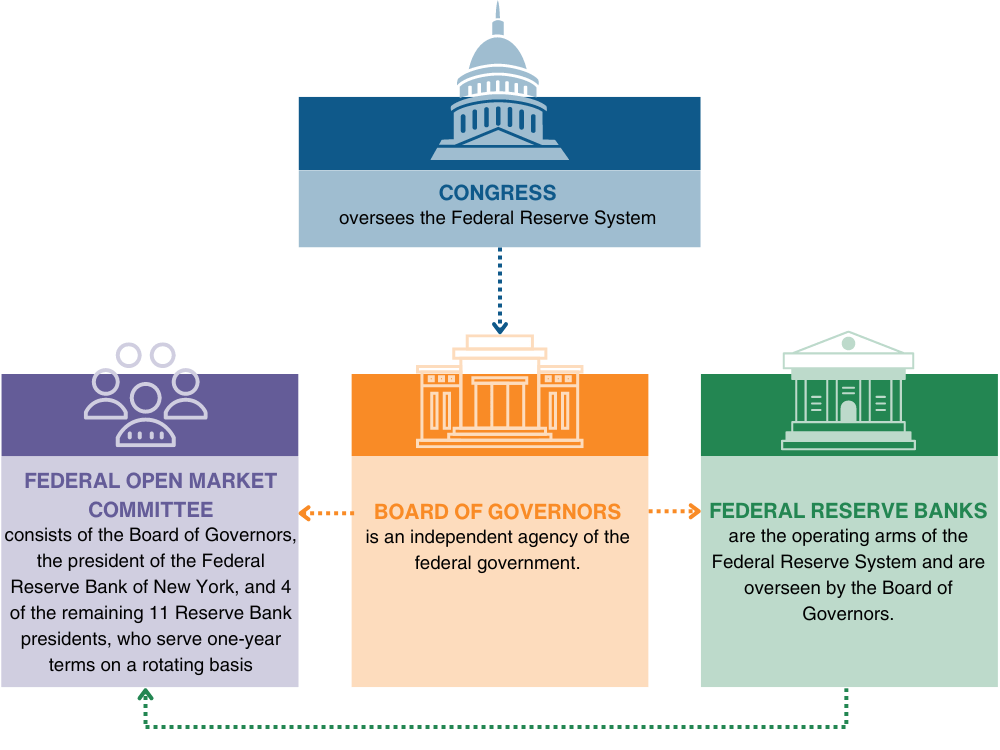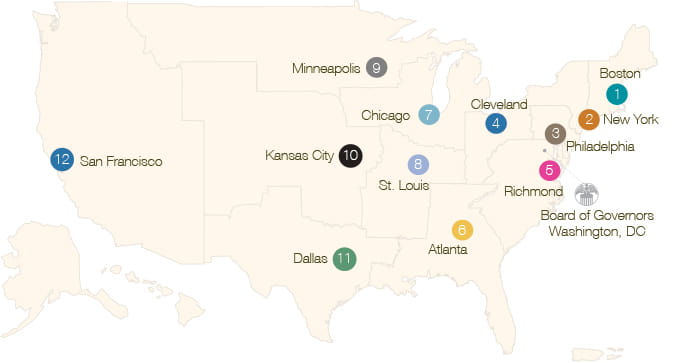Understanding the Federal Reserve’s Structure
The Federal Reserve is the central bank of the United States. It's a hybrid System of national offices and regional Districts, including the Cleveland Fed's. Our unique structure supports our mission to foster a safe and stable monetary system that works for all.
How the Fed began
How the Fed works
How the Fed is structured
Keeping our economy safe and sound since 1913
Congress established the Federal Reserve System in 1913 as the central bank to provide the nation with a safer, more flexible, and more stable monetary and financial system. The Federal Reserve System, also referred to as the Fed, includes 12 independent, regional Reserve Banks throughout the United States, the Board of Governors in Washington DC, and the Federal Open Market Committee (FOMC).
The Federal Reserve is the third central bank established in US history. The first and second “banks of the United States” failed in the nineteenth century. The turbulence of the financial markets at the beginning of the twentieth century led to the creation of the Federal Reserve, an innovative, hybrid System of federal and regional entities.
How the Fed works
 of the Federal Reserve Bank of New York, and 4 of the remaining 11 Reserve Bank presidents, who serve one-year terms on a rotating basis; Board of Governors is an independent agency of the federal government; Federal Reserve Banks are the operating arms of the Federal Reserve System and are overseen by the Board of Governors." width="1000" height="750" />
of the Federal Reserve Bank of New York, and 4 of the remaining 11 Reserve Bank presidents, who serve one-year terms on a rotating basis; Board of Governors is an independent agency of the federal government; Federal Reserve Banks are the operating arms of the Federal Reserve System and are overseen by the Board of Governors." width="1000" height="750" />
The Fed’s decentralized structure helps us monitor economic conditions closely and understand the challenges facing communities, industries, and small businesses in different parts of the country. We are nonpartisan and independent by design, insulated from short-term political considerations to work for the longer-run best interests of the US economy.
In times of crisis, we ensure that money keeps flowing through the economy, and we do what we can to soften the impact of the fluctuations of financial markets.
Congress gave the Fed two goals, often called a dual mandate:
- price stability—so that your dollar is worth about the same tomorrow as it is today.
- maximum employment—the highest level of employment the economy can sustain while keeping a stable rate of inflation.
We work toward these goals mainly by influencing interest rates and supporting financial stability.
The Federal Reserve structure and its functions
Reserve Banks

There are 12 regional Reserve Banks that work independently with oversight from the Board of Governors in Washington DC. The Reserve Banks are the operating arms of the Federal Reserve System and function within their own geographical Districts. The Fed identifies its districts by number and the city in which its main office is located. For example, the region served by the Federal Reserve Bank of Cleveland is known as the Fourth District.
Each Reserve Bank has a nine-member board of directors that serves as a link between the Federal Reserve and the private sector. Directors come from a range of backgrounds and bring valuable insights into the economic conditions within each District.
The part of the Federal Reserve’s work most visible to the American public is our role in circulating cash throughout the economy, both banknotes and coins. We ensure that financial institutions have enough currency on hand to satisfy the public’s demand, even if that demand spikes.
While we don’t print money—that’s the Bureau of Engraving and Printing, and the US Mint for coins—we do distribute cash and monitor its physical state. Every banknote is first sent out from a Reserve Bank before eventually coming back through a Reserve Bank’s cash processing facility. We look at each bill to decide whether it’s fit to continue in circulation. If it’s not, we shred it.
When you look at a dollar bill, you’ll see a stamp on one side with a letter within a “starburst” pattern. That letter tells you which Reserve Bank first released the bill into circulation. If you see a “D,” that means the Cleveland Fed originally sent it out.
Less apparent to the public at large is our role in working with banks and other financial institutions to make sure that they comply with banking laws, that they’re creditworthy to borrow money (just like people), that they file all required reports, and that the financial system is safe from cyberattacks. Learn more about our supervision and regulation work.
Board of Governors
The Board of Governors is a federal agency in Washington DC and the governing body of the Federal Reserve System. The Board has seven members, or “governors,” who are nominated by the president of the United States and confirmed by the Senate. These governors guide all aspects of the operations of the Federal Reserve and its five key functions. The Board is accountable to Congress, which designed the Fed to perform its duties free from short-term political influence.
Federal Open Market Committee
The FOMC sets national monetary policy. The committee consists of 12 voting members—the seven governors, the president of the Federal Reserve Bank of New York, and four of the other 11 Reserve Bank presidents who serve one-year terms on a rotating basis.
Fed governors and the Reserve Bank presidents share insights into regional conditions in their Districts. The FOMC meets in Washington DC eight times a year. During the meetings, its members
- review regional financial and economic conditions and release economic projections
- set monetary policy by voting on key decisions about interest rates
- communicate with the public about their decisions
About the Cleveland Fed
Headquartered in Cleveland, with branches in Cincinnati and Pittsburgh, our District is known for manufacturing and our Bank specializes in inflation research and US Treasury payment systems.
Ready to learn more about the Federal Reserve?
Visit federalreserve.gov to view The Fed Explained: What the Central Bank Does that provides further details about the structure, responsibilities, and work of the US central banking system.
Careers
Explore opportunities for meaningful work. View job descriptions, application requirements, our hiring process, and our compensation and benefits.
News and Events
View all news and events from the Federal Reserve Bank of Cleveland
Federal Reserve Bank of Cleveland
The Cleveland Fed is part of the Federal Reserve, the central bank of the United States. With offices in Cleveland, Cincinnati, and Pittsburgh, we serve an area that comprises Ohio, western Pennsylvania, eastern Kentucky, and the northern panhandle of West Virginia. The goal of our work is to strengthen the economic performance of the nation and our region. Learn more about us and what we do.
Cleveland office
1455 East 6th Street Cleveland, OH 44114
Cincinnati office
150 East Fourth Street Cincinnati, OH 45202
Pittsburgh office
One Oxford Centre, Suite 3000 301 Grant Street Pittsburgh, PA 15219
CLEVELAND FED DIGEST

The latest from us, directly to you
Sign up for our monthly newsletter to get the latest research, expert interviews, and upcoming events from the Cleveland Fed.
Get answers to inflation questions

Inflation is complicated, so our experts help explain it
View the Infographics on Inflation series from the Center for Inflation Research.
- Careers
- About Us
- Diversity & Inclusion
- Fraud Awareness
- Privacy Policy
- Contact Us
- LinkedIn
- Facebook
- Cleveland Fed on X Twitter Social Media
- Instagram
- YouTube
© 2024 Federal Reserve Bank of Cleveland
https://www.clevelandfed.org/about-us/understanding-the-federal-reserve
We care about privacy
This website uses cookies to ensure the best user experience. By continuing use of our website, you agree to our Privacy Policy

 of the Federal Reserve Bank of New York, and 4 of the remaining 11 Reserve Bank presidents, who serve one-year terms on a rotating basis; Board of Governors is an independent agency of the federal government; Federal Reserve Banks are the operating arms of the Federal Reserve System and are overseen by the Board of Governors." width="1000" height="750" />
of the Federal Reserve Bank of New York, and 4 of the remaining 11 Reserve Bank presidents, who serve one-year terms on a rotating basis; Board of Governors is an independent agency of the federal government; Federal Reserve Banks are the operating arms of the Federal Reserve System and are overseen by the Board of Governors." width="1000" height="750" />

